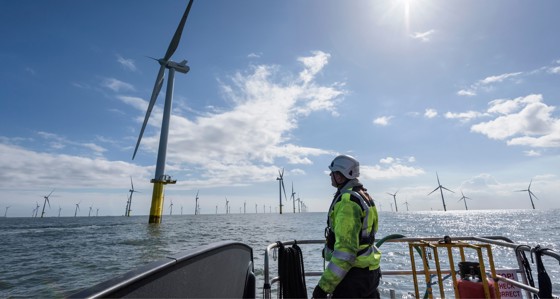District heating networks have an important role to play if the UK is to reach net zero emissions. But for that to happen, regulation is required to protect customers and ensure district heating delivers on its low carbon potential.
District heating networks – systems of insulated pipes that distribute thermal energy from a central source to multiple buildings – could play an integral role in meeting the UK’s net zero carbon emissions by 2050.
Heat networks currently serve about 500,000 (3%) UK homes. This must increase to 4.5 million (18%) homes by 2050 if we are to achieve net zero(1) .
However, the heat network market is unregulated. This means that customers on heat networks are not on an equal footing with those served by gas heating solutions, with instances of poor network technical performance compounding the issue. The problem is further exacerbated by prevailing high energy prices, where customers are not provided with the same level of energy bill protection as residential customers on regular supply contracts. In addition, a promised £200 support payment was recently removed(2).
The current energy crisis has increased public awareness around the need to reduce reliance on gas imports, while at the same time, traditional energy players, infrastructure funds, local authorities and technology providers, see potential in the district heating market and have funds available and ready for investment into heat networks. Regulation is needed now to protect customers, accelerate investment and provide confidence in the heat network market to drive us towards a low carbon future.
Some Local Authorities are exploring the benefits of such schemes in their local areas and the investment community is seeking to identify opportunities to fund schemes.
With regulation in place Local Authorities will be able determine the right process for development, create some level of standardisation, de-risk heat network projects by improving the market’s reputation to grow the customer base, and support the scaling of heat networks, which will draw in infrastructure funds
However, regulatory uncertainty is ultimately deterring private investment; meanwhile insights from Baringa’s engagement with the investor community have revealed a nervousness among investors to associate their brand with companies and schemes that are failing to deliver a good customer service.
What effective regulation could look like
The design of heat network regulation is as important as its implementation. Ofgem and BEIS both have vast experience in building and adapting regulatory frameworks for other parts of the energy market that can be applied to heat. A flexible framework that is fair and transparent for the customer will be essential to foster innovation, encourage competition and unlock district heating’s potential.
For effective design of regulation that is fair for customers and suppliers alike, Baringa has outlined three key requirements that should be at the heart of heat network regulatory design:
- Make it investable – price, connection and the natural monopoly of heat networks are key demand-side barriers to scaling of heat networks. To make the technology investable, regulation must play a role in removing or diminishing each barrier.
- Make it clear – over time, regulation becomes more complex and detailed to evolve with assets as they mature – think how electricity distribution price controls have become much more involved from DPCR2(3) in 1996 to RIIO2 in the early 2020s. However, to begin with, making regulations clear and comprehensible is essential to allow risks to be fully understood and remove uncertainty.
- Protect the customer – today, the Heat Trust provides customer protection, but with Ofgem confirmed as regulator of heat networks we expect a formalisation of consumer protection. In line with parallel utilities, we expect a statutory duty to protect customers, improving the reputation of heat networks as a low carbon heating option.
In February 2020 the Department for Business, Energy & Industrial Strategy (BEIS) opened a consultation on a regulatory framework for district heating, which included proposals for a regulator to be granted enforcement powers across quality of service, provision of information and pricing arrangements for all domestic heat network consumers.
For heat networks today, we agree with BEIS’s assessment in the 2020 consultation that there is no single regulatory model that is directly transferable to the heat network market today given the current level of technology maturity. However, setting appropriate technical standards while simultaneously allowing enough flexibility and innovation in design of today’s regulation is essential.
Flexibility is essential for a dynamic market
Allowing for flexibility in the implementation of heat network regulation is essential. Prescriptive approaches to regulation can work in a stable environment but are less effective where commercial and technological change is rapid. For example, recent events in the retail energy market require rapid changes to the regulatory framework, including the price cap. Similarly, even well-established processes, such as network price controls, are being increasingly tested through faster technological changes and network needs, driven by net zero.
Enabling a flexible market alongside regulation
Implementation of regulation is only part of the heat network puzzle. Regulation is key in facilitating a step change in heat network deployment but enabling flexibility can also be achieved by working around regulation.
For example, an unbundling of heat networks would allow for regulation to target specific points of the value chain, such as into generation, network and customer components, allowing for regulatory models that are reflective of each component’s differing risk profile.
The BEIS’s assessment(4) that regulated asset base is not an appropriate model for heat networks may not apply to an unbundled market. Unbundling the market ahead of regulatory intervention would allow for flexibility, the development of attractive customer models and increased innovation, encouraging all stakeholders in the market to work together to reduce barriers to heat market growth.
Laying a foundation
In whichever way the UK designs and implements a heat network regulation model, it is important for regulation to give customers the confidence that they will be fairly treated and charged, and not put at a disadvantage to consumers using gas. This will be essential for growing the heat network market and bringing in investment to develop new capacity as we transition to net zero.
Ultimately, enabling new innovative propositions with the right regulatory support would unlock huge growth in the district heating market, accelerating the UK on the path to net zero and protecting customers.
Sources:
1. Baringa analysis based on UK Government ambition
2. Heat network customers, who were originally promised £200 as part of the Autumn Statement for support with energy bills, are no longer due to receive promised payment
Energy bills support: Half a million households on heat networks miss out on £200 after Government U-turn (inews.co.uk)
3. Distribution Price Control Review 2 ran from April 1996 – March 2000, after Offer re-opened DPCR1 which started in 1995.
4. BEIS, February 2020 consultation
For more information, get in touch:
Related Insights

European power markets: Navigating the new normal and looking to the future
How will the power markets evolve in 2024 and beyond? Watch the playback of this webinar to access our analysis.
Read more
Digital transformation and decarbonisation in the energy sector
Energy leaders are using digital technologies and data to fast-track their journeys to decarbonisation.
Read more
The Great British Retrofit: the scaling of the supply chain to achieve home decarbonisation in the UK
The recent COP28 deal has committed over 200 countries to transition away from fossil fuels, signalling a clear call to action. What are the challenges and opportunities for the UK to meet the decarbonisation targets for the UK housing stock?
Read more
Floating offshore wind - The quest for scale
Harvesting wind in previously inaccessible seabed areas has many advantages, but there are some obstacles that need to be overcome before we can deploy floating offshore wind at scale.
Read more